Manage the Forests[Home]
(GS 106-870, 106-875, 106-1001/1002, 113A-52.1)
The NC Forest Service assists private landowners in responsibly managing their forest resources. We also monitor The Forest Practices Guidelines (FPGs) Related to Water Quality in order to protect our water resources. We prepare objective-driven management plans for private landowners, assist landowners in implementing recommended management practices and promote sound management of North Carolina's urban forests.
Objective - Forest Management
Increase the acres of forest land under active management.
Forest Management Action Items:
- Key Initiative - Develop a web-based Prescribed Fire Plan generator and a Smoke Management database. Lead - Safety, Planning and Analysis
- Work with NC Forestry Association (NCFA) and the Legislature to evaluate and improve the FDP Program. Lead - State Forester's Office
- Increase NCFS forestation program capabilities where needed by procuring better forestation equipment and increase efficiencies through the use of technology. Lead - Regional Foresters
- Tailor FM activities/recommendations so they meet landowner objectives and encourage implementation. Lead - FM Branch
- Develop and implement customer satisfaction protocols using results for continuous Improvement (plan writing, implementation rates and increased customer base) Lead - FM/FD Division
- Strengthen and support forest nursery and tree improvement programs to ensure a stable supply of seedlings. Lead - FM/FD Division
- Develop an acquisition plan to increase lands being managed by NCFS. Lead -State Forester's Office
- Work with various groups to develop strong Forest Landowner Associations in each county or group of counties. Lead - Regional Foresters
- Implement focused outreach campaigns to promote forest management. Leads - I&E Branch and FM Branch
Objective - Water Quality
Increase the effectiveness of the NCFS Water Quality program.
Water Quality Action Items:
- Retain or increase forestland within watersheds and riparian areas and educate the public on the values of these forested watersheds and riparian areas. Lead - FM Branch and NPS Branch
- Implement recommendations within the most current version of the BMP Survey. Lead - NPS Branch
- Be proactive in searching the county for possible ownerships needing our services. (Water quality flights for multiple purposes, cold calls to recently harvested tracts, concentrated efforts in one part of the county in a given year, etc.) Lead - Regional Foresters
- Increase field staff and associated funding to implement and improve the water quality program, especially in the mountain counties. Lead - State Forester's Office
Objective - Urban Forestry
Develop and promote an urban-focused effort that meets ownership objectives for urban-rural interface landowners and communities.
Urban Forestry Action Items:
- Provide assist to municipalities on obtaining managing status on the USFS CARS report. Lead - Urban & Community Forest Branch
- Increase assistance in the development of community forest. Lead - Urban & Community Forest Branch
| Progress Graph | Measures - Safety | Baseline | June 30, 2016 Target |
|---|---|---|---|
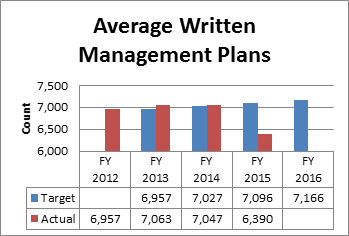 |
The annual number of written management plans to private forest landowners and the annual acres addressed within those plans. Plans contain forest management recommendations based on the owner's management objectives. Our goal is to maintain or slightly increase both the number of management plans and the number of acres addressed by management plans by June 30, 2016. | 6,957 plans/year addressing 366,032 acres/year | 6,957-7,166 plans/year addressing 366,032-377,013 acres/year |
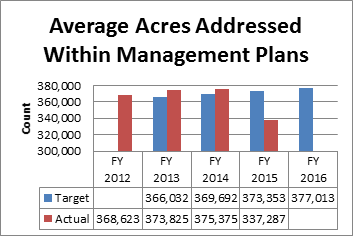 |
|||
| This is a two-part measure. These measures will come from the 4220 Forest Management Accomplishment Report. For "Management Plans" the calculation is the "Count, or Number of Activities" of all plan types. For "Acres" the calculation is "Total Acres" for all plan types. The baseline will be the average of the last five SFY's ending on June 30, 2012. The target will be the five previous SFY's ending June 30, 2016. Quarterly reporting will be the cumulative year to date acreage, with the annual report to be the current year's achievement. To be reported by the Forest Management/Forest Development Section. | |||
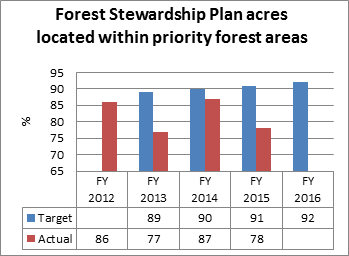 |
Percentage of Forest Stewardship Plan acres located within priority forest areas that are being implemented by landowners. Priority forest areas are identified in NC's Forest Action Plan indicating areas of high conservation value or at risk of conversion to non-forest use. Our goal is to increase the rate 3 to 6 percentage points by June 30, 2016. | 86% located in priority areas | 89-92% located in priority areas |
| This measure will come from the annual USFS PMAS report for the Forest Stewardship Program. It is calculated as the Current Plan Priority Acres Implemented divided by the Current Plan Priority Acres and expressed as a percent. The baseline uses the 2011 PMAS report values. The target will be the five previous SFY's ending June 30, 2016. To be reported annually in January by the Forest Management/Forest Development Section. | |||
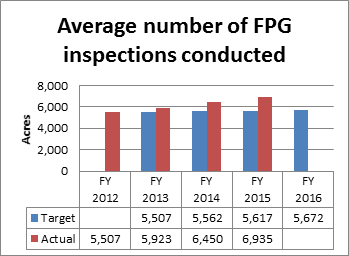 |
Total number of FPG inspections conducted annually. These inspections determine compliance with the FPGs. Our goal is to maintain or increase the current level by up to 3 percentage points by June 30, 2016. | 5,507 inspections/year | 5,507-5,672 inspections/year |
| This measure will come from the 4220 Forest Management Accomplishment Report. The calculation will be the total of all FPG inspections (including re-inspections) in the reporting system for the SFY. The baseline will be the average of the last five SFY's ending on June 30, 2012. The target will be the five previous SFY's ending June 30, 2016. Quarterly reporting will be the cumulative year to date total, with the annual report to be the current year's achievement. To be reported by the Forest Management/Forest Development Section. | |||
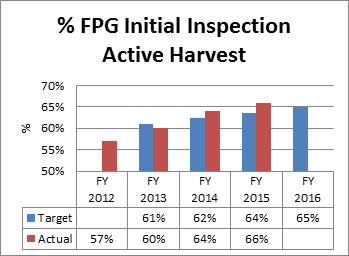 |
Annual percentage of initial FPG harvest inspections conducted on forestry sites that are still active. Our intent is to conduct the initial inspection when forestry operations are active as opposed to after they have been closed-out. This proactive approach results in more timely resolution of water quality issues, and can prevent problems from occurring in the first place. Our goal is an increase of 4 to 8 percentage points by June 30, 2016. | 57% of inspections are initial inspections on active harvest operations | 61-65% of inspections are initial inspections on active harvest operations |
| This measure will come from the 4220 Forest Management Accomplishment Report. In simple terms, it is the total initial active harvest inspections divided by the total of all initial harvest inspections (active + complete). The baseline will be the average of the last five SFY's ending on June 30, 2012. The target will be the five previous SFY's ending June 30, 2016. Quarterly reporting will be the cumulative year to date percentage, with the annual report to be the current year's achievement. To be reported by the Forest Management/Forest Development Section. | |||
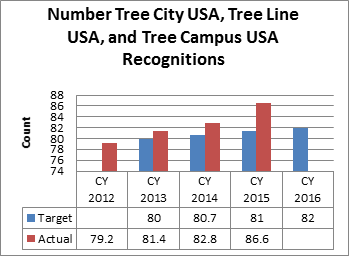 |
Number of annual Tree City USA, Tree Line USA, and Tree Campus USA recognitions. Our goal is to increase the number of recognitions by 2 to 4 by 2016. | 78 recognitions | 80-82 recognitions |
| This is a direct measure from Urban and Community Forestry Program records. The baseline will be the number of recognitions in CY 2012. The target will be the number of recognitions in CY 2016. This measure will be reported annually in the first quarter of each CY. To be reported by the Forest Management/Forest Development Section. | |||
